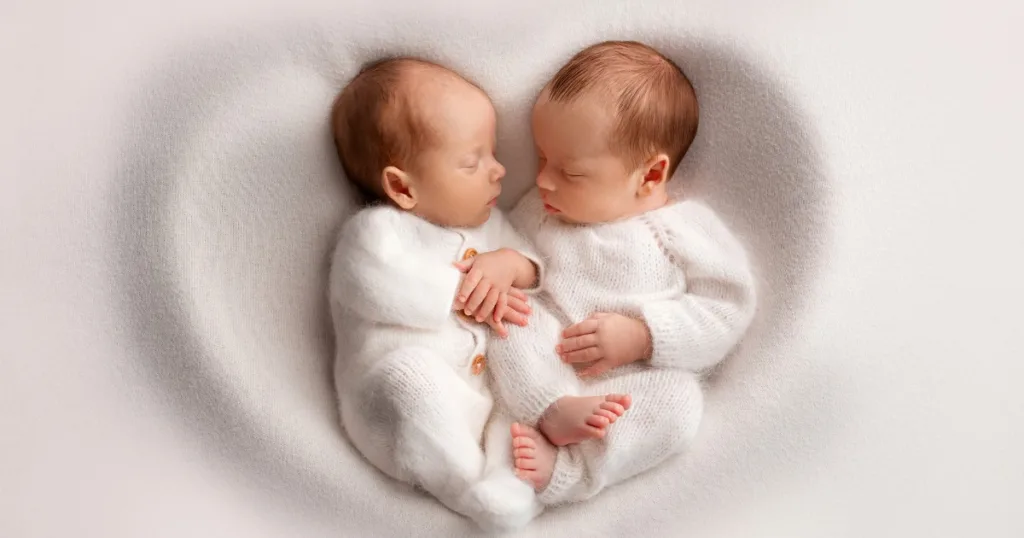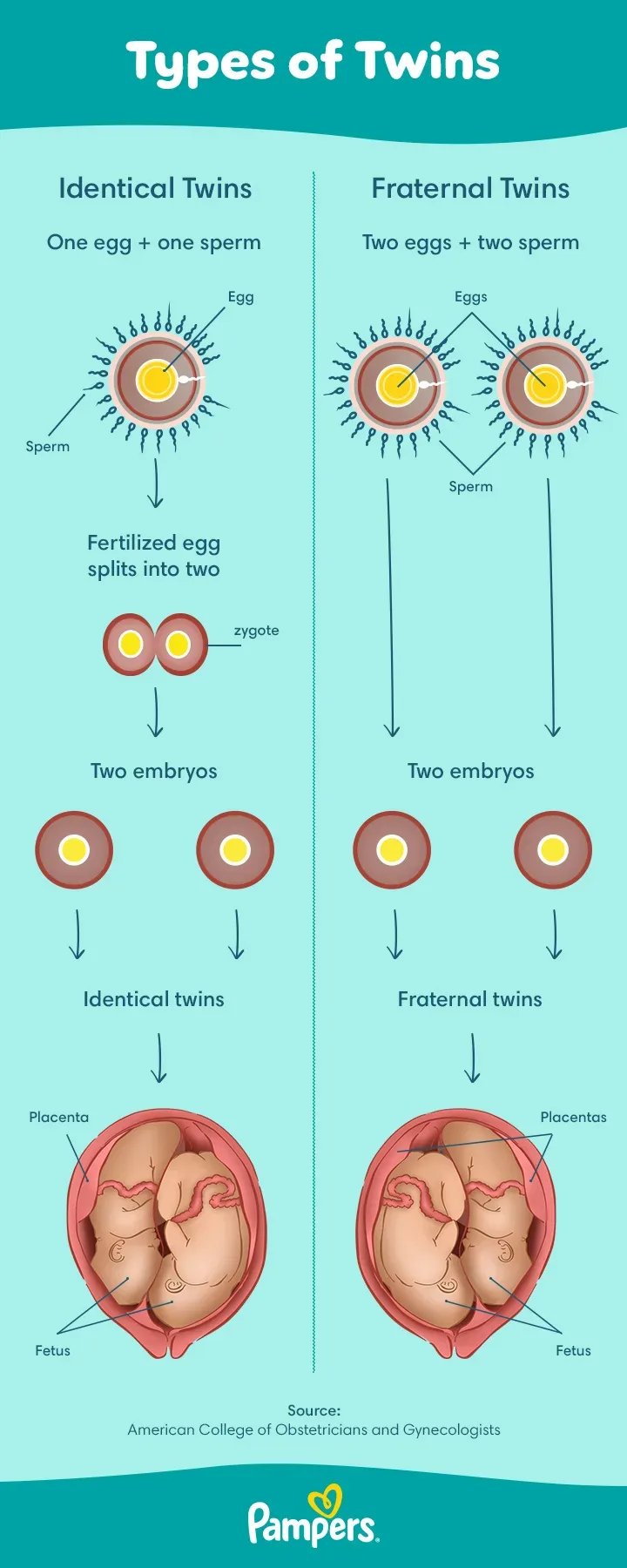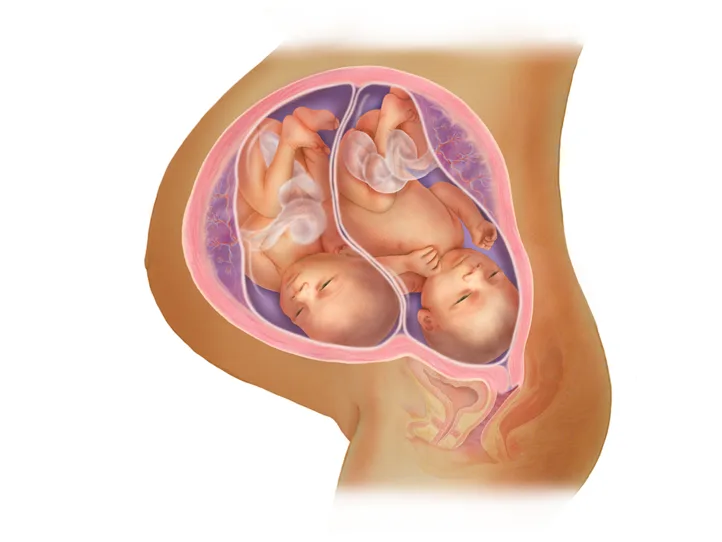
Twin Pregnancy Week by Week: Your Babies’ Growth Journey
Expecting twins? Congratulations! As a twin mom, your pregnancy journey is unique, and watching your babies grow week by week is incredibly exciting. This guide will walk you through your twin pregnancy week by week, detailing how your little ones are developing, along with fun size comparisons to help you visualize their progress. Let’s dive in!
Table of Contents
We are an Amazon associate and may make a small commission from the products we recommend. We will only recommend products we personally use or believe in that have been recommended by twin parents.

Diagram: Pampers Types of Twins
Twin Pregnancy Week by Week: First Trimester
Twins implantation
Before we break down twin pregnancy week by week, let’s first go over the different types of twins. Fraternal and Identical.
Nonidentical twins (also known as fraternal or dizygotic twins) are the most common. Each baby grows from a separate fertilized egg (zygote). Each has their own placenta and amniotic sac.
By 3 weeks, each zygote has developed into a ball of several hundred cells, called a blastocyst, and is burrowing into the uterine lining. Because they have different chromosomes, your fraternal twins may or may not be the same gender.
On the other hand, if you’re having identical twins, that means one egg was fertilized and split into two, creating two embryos. They will share a placenta but may or may not have their own amniotic sac. Because they have the same chromosomes, they will look alike and be the same gender. (Source: Baby Center).
Weeks 1-4: Conception & Early Development
- What’s happening: In the first few weeks, your body prepares for pregnancy, and once fertilization occurs, two embryos begin to develop.
- Size of the babies: At week 4, each embryo is about the size of a poppy seed.
Weeks 5-6: Heartbeats Begin
- What’s happening: By week 5, your babies’ hearts begin beating. Basic features like the neural tube, which will become their brains and spinal cords, start forming.
- Size of the babies: Around week 6, your babies are each the size of a sweet pea.
Week 7: Growing Limbs
- What’s happening: Your twins are starting to grow little arms and legs. Their brains are developing rapidly, too!
- Size of the babies: By week 7, your babies are about the size of a blueberry.
Week 8: Forming Fingers and Toes
- What’s happening: Fingers and toes begin to form, though they may still be webbed. Eyelids are also developing.
- Size of the babies: Each twin is now about the size of a raspberry.
Week 9: Moving Around
- What’s happening: Your babies are starting to move! While you can’t feel them yet, they’re wriggling and shifting.
- Size of the babies: They’ve grown to the size of a grape.
Week 10: Starting to Look Human
- What’s happening: By now, the tail that was part of their early development has disappeared, and they’re starting to look more like tiny humans.
- Size of the babies: Each baby is about the size of a kumquat.
Week 11: All Systems Go
- What’s happening: Vital organs like the kidneys, intestines, brain, and liver are all developing further. Hair follicles are forming, too.
- Size of the babies: By week 11, your twins are each the size of a fig.
Week 12: Fingernails Form
- What’s happening: Their fingernails and toenails are forming. Their faces are taking shape, and their intestines are moving into the abdomen.
- Size of the babies: Now, they’re each the size of a lime.
As you make your way through your first trimester in twin pregnancy week by week, you’ll probably experience some common pregnancy symptoms as your twins develop, including implantation bleeding, a missed period, nausea, fatigue, and breast tenderness. Your body is hard at work to help your babies form limbs; develop faces; sprout fingers and toes; form brains, spinal cords, and other organs; and more!
Twin Pregnancy Week by Week: Second Trimester
Week 13: Second Trimester Begins
- What’s happening: You’re entering the second trimester, and your twins’ bones are beginning to harden.
- Size of the babies: At week 13, they’re each about the size of a peapod.
Week 14: Growing Hair
- What’s happening: Your babies are developing tiny hairs all over their bodies called lanugo, which helps keep them warm.
- Size of the babies: By week 14, they are each the size of a lemon.
Week 15: Making Faces
- What’s happening: Your twins are starting to develop facial expressions as their muscles grow stronger.
- Size of the babies: Each baby is now about the size of an apple.
Week 16: Hearing Begins
- What’s happening: Your babies’ ears are starting to work, and they can now hear sounds, including your voice.
- Size of the babies: At week 16, they’re the size of an avocado.
Week 17: Developing Fat Stores
- What’s happening: Your babies are building fat, which will help regulate their body temperatures after birth.
- Size of the babies: By week 17, they’re each the size of a turnip.
Week 18: Feeling Movements
- What’s happening: You might start feeling little flutters as your babies get more active.
- Size of the babies: At week 18, they’re about the size of a bell pepper.
Week 19: Skin Development
- What’s happening: Your twins’ skin is forming, though it’s still translucent. The vernix, a protective coating, is developing to protect their skin.
- Size of the babies: Each baby is now the size of a tomato.
Week 20: Halfway Point
- What’s happening: You’ve reached the halfway mark! Your babies’ senses, including taste, are developing.
- Size of the babies: By week 20, they’re each the size of a banana.

Photo: Baby Center, 20 weeks with twins
Week 21: Digestive System Matures
- What’s happening: Your twins are now absorbing small amounts of amniotic fluid, which is helping their digestive systems to mature.
- Size of the babies: Each baby is about the size of a carrot.
Week 22: Developing Eyelids
- What’s happening: Their eyelids, lips, and eyebrows are becoming more distinct, though their eyes remain shut for now.
- Size of the babies: By week 22, they’re the size of a spaghetti squash.
Week 23: Preparing for Life Outside the Womb
- What’s happening: Their lungs are developing, getting ready to breathe air after birth.
- Size of the babies: At this stage, each baby is about the size of a mango.
Week 24: Gaining Weight
- What’s happening: The babies are gaining more weight, and you might start to notice more pronounced kicks.
- Size of the babies: By week 24, they’re each the size of an ear of corn.
Week 25: Opening Eyes
- What’s happening: Your twins are starting to open their eyes. Their hair is also getting thicker!
- Size of the babies: Each baby is about the size of a cauliflower.
Week 26: Breathing Amniotic Fluid
- What’s happening: Your babies are practicing breathing by inhaling and exhaling small amounts of amniotic fluid.
- Size of the babies: By week 26, they’re each about the size of a head of lettuce.
Week 27: Wrapping Up the Second Trimester
- What’s happening: You’re nearing the end of the second trimester. Your babies’ brains are rapidly developing, and they’re getting ready for life outside the womb.
- Size of the babies: Each baby is now the size of a cucumber.
Morning sickness and fatigue may start to subside at the beginning of your second trimester. Inside your belly, your babies’ bones are starting to harden, and your little ones are beginning to move their arms and legs. You’ll begin to feel little flutters when they move around. Occasionally, you may even feel them have hiccups!
Twin Pregnancy Week by Week: Third Trimester
Congratulations on entering the third trimester! This is the home stretch as your twins prepare for life outside the womb. Below is a continuation of your twin pregnancy week by week, covering each week of the third trimester and tracking your babies’ growth and development.
It is common for twins to arrive earlier than 39-40 weeks. In fact, depending on your pregnancy and your own health your doctor may recommend delivering by 38 weeks. Mine were born at 34+4 when my water broke and they came on their own.
Week 28: Developing Sleep Patterns
- What’s happening: Your babies are developing regular sleep and wake patterns, and their brains are rapidly growing.
- Size of the babies: Each twin is now about the size of an eggplant.
TIP: Pack your Hospital Bag Now to be Prepared. Click here for our packing list guide >
Week 29: Kicking and Stretching
- What’s happening: You may feel more pronounced kicks and stretches as the babies grow stronger. They’re also starting to regulate their body temperature.
- Size of the babies: By week 29, they’re each the size of a butternut squash.
Week 30: Growing Lungs
- What’s happening: Their lungs continue maturing, and they are practicing breathing. You may notice stronger movements as the womb becomes a little tighter.
- Size of the babies: Each baby is about the size of a cabbage.
Week 31: Brain Connections
- What’s happening: Your twins’ brains are making crucial neural connections. Their sense of sight is improving, and they can detect light changes even from inside the womb.
- Size of the babies: By week 31, they’re the size of a coconut.
Week 32: Packing on the Pounds
- What’s happening: Your babies are gaining fat quickly, preparing them for life outside the womb. Most twins born after this week have a good chance of thriving with medical care if delivered prematurely.
- Size of the babies: At this stage, each baby is about the size of a jicama.
Week 33: More Growth Spurts
- What’s happening: Your twins are still growing rapidly. Their bones are hardening, and they’re getting stronger by the day.
- Size of the babies: By week 33, they’re each the size of a pineapple.
Week 34: Detecting Voices
- What’s happening: Their hearing is fully developed, and they can distinguish familiar voices, including yours and your partner’s.
- Size of the babies: Each twin is about the size of a cantaloupe.
Week 35: Positioning for Birth
- What’s happening: Your twins are likely settling into a head-down position, getting ready for birth. There’s less room for movement, but they’re still wriggling in the space they have left.
- Size of the babies: By week 35, they’re each the size of a honeydew melon.
Week 36: Final Touches
- What’s happening: The twins are almost fully developed. They’re plumping up, and their skin is becoming less wrinkled. Their digestive system is almost ready to function independently.
- Size of the babies: At week 36, they’re about the size of a papaya.

Photo: Baby Center, 36 weeks with twins
Week 37: Almost Full Term
- What’s happening: Your babies’ lungs are mature, and they’re considered near-term. At this stage, many twins are born, and they generally do very well outside the womb.
- Size of the babies: By now, each twin is the size of a romaine lettuce head.
Week 38: Ready for the World
- What’s happening: Your twins are full term, and all their organs are fully developed. They’re just waiting to meet you!
- Size of the babies: Each baby is now about the size of a pumpkin.
Week 39-40: Birth Time (typically for twins, this happens by 38 weeks or before)
- What’s happening: If you haven’t delivered yet, your twins are simply waiting for their grand debut. At this point, most twin pregnancies will be delivered, either naturally or via scheduled C-section.
- Size of the babies: By week 39 or 40, your twins are each about the size of a watermelon.
The third trimester of pregnancy goes by quickly, as twins are usually born earlier, often between 34-38 weeks. It’s also more common to have a cesarean section when pregnant with twins – but this doesn’t necessarily have to be so. You can start to prepare for your babies’ arrival a little early, so that you’re ready to welcome them into their new home!
You may experience some discomfort and swelling in the third trimester with twins. So don’t wait until the last minute to prepare the nursery or your hospital bag. Have it all done, if possible, by 28 weeks.
To summarize a few important differences between a singleton pregnancy and a twin pregnancy, these might include:
- more checkups with your health provider
- increased weight gain
- a larger baby bump
- an earlier delivery
- your twins might possibly need a little extra time in the hospital NICU
- higher risk for cesarean delivery and premature birth
To view images of twin fetal development, visit BabyCenter’s Fetal Development Images, which offers a beautiful gallery of visuals for each stage of pregnancy.
With each passing week, your twins are growing and developing, getting ready to meet you soon. Congratulations on making it this far in your pregnancy journey!
Sources:
Create Your Free Twin Baby Registry® today. Planning for two-can be so much fun!®
Click the button below to get started planning for your twins today.

Leave a Reply